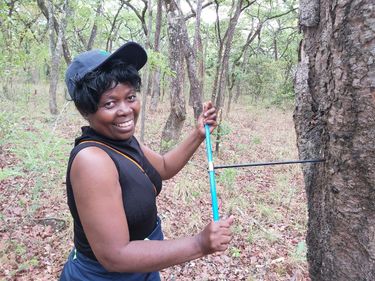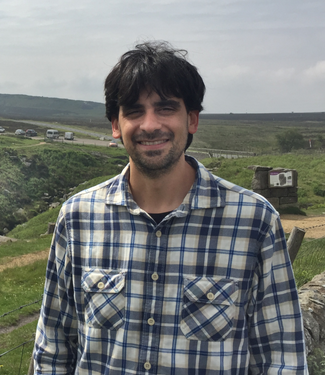
Sessions in which Mareike Hirsch participates
Tuesday 28 June, 2022
As of 2020, 56% of the world’s population live in urban areas. These individuals benefit from numerous ecosystem services provided by urban forests, including urban heat island mitigation, energy use reduction, stormwater interception, wildlife and pollinator habitat provision, air pollution removal, and carbon sequestration. Urban greenspaces are also often the most accessible avenue for exposure to the natural environment, providing additional aesthetic, recreati...
Urban trees provide multiple benefits such as shading and cooling, which become more and more important due to the increasing frequency and severity of heat and drought periods. It is thus necessary to identify tree species, which are able to tolerate such extreme conditions in urban areas. We studied the resistance and resilience of stem diameter growth of five deciduous tree species in an urban area in Southwest Germany to three exceptional drought periods for differences between and wit...
Sessions in which Mareike Hirsch attends
Monday 27 June, 2022
Free, in person and onlineThe stable isotopic compositions of carbon and oxygen (d13C and d18O) measured in tree rings are valuable proxies for reconstructing paleoclimate and are increasingly used as paleophysiological proxies. Applying these proxies in ecophysiology and paleoclimate can be challenging as they rely on complex process-based models and poorly constrained input data. In recent years, h...
Tuesday 28 June, 2022
Africa is faced with a number of challenges including climate change and ecological disturbance due to various anthropogenic activities. These problems adversely affect the forests and also ecosystem services. My appreciation for the forests motivated me to pursure my undergraduate studies in Forestry. I first applied dendrochronology during my PhD research which focused on understanding the climate change vulnerability of the Zambezi teak forests in Zambia. However, lack of research facil...
Climate change poses an existential threat to trees, given our understanding of the importance of climate in shaping their geographic distributions. Climate envelope models are commonly used to predict how species will respond to climate change. These models give rise to the leading edge-trailing edge paradigm for range change: populations at the cool edge of a species’ distribution are expected to benefit from warming, whereas populations at the warm edge are expected to decline. We chall...
Forest disturbances and tree growth are major drivers of dynamics and long-term carbon storage in forests. Combining forest inventory data and tree-ring analysis allows for a retrospective estimate of aboveground forest biomass (AGB) and disturbance dynamics at decadal to centennial scales, both being directly related to net primary productivity (NPP). We used this combined approach to estimate precisely-dated ages of aboveground carbon in over 20 temperate old-growth forests in Western Eu...
The spatial scale of climate fluctuations, or effective spatial degrees of freedom (ESDOF), depends on the timescale and the forcing: while local scale variability between far away locations may be independent on short timescales, they may become coherent over sufficiently long timescales, or if they are driven by a common forcing. While ESDOF have been estimated from instrumental data over the historical period and climate model simulations, it remains difficult to perform such analysis o...
"Emerging in the early 20th century, the scientific study of tree-rings has a rich but under-cultivated history. This project reviews the historiography (or the history of historical writing) of dendrochronology. From the pioneering work of A.E. Douglass and others to the establishment of institutions dedicated to advancing dendrochronology by the 1950s, the field has secured its place as an ensemble of techniques to interpret tree rings, with applications in archeology, climatology, ecolo...
Ultra high resolution imaging is becoming standard across the sciences and must be a priority for dendrochronology. Large format scanners fail to resolve micro rings and the anatomical structures of increasing scientific interest. Meanwhile, current software limitations include cost, user experience, data management flexibility, and capacity for handling large file sizes. We argue for a new paradigm and present a technology framework that integrates gigapixel macro photography, a cloud-hos...
Tree-ring research has given generations of scientists a long memory of what is acceptable for a tree to be included for data analysis. The established criteria, however, were set through purposeful goals to maximize the response for climatic reconstructions. Ecology is different. Tree-rings are increasingly being used to study a wide swath of ecology, including the carbon cycle or the response of ecosystems to global changes. A fundamental aspect of ecology is to understand the range of r...
Montane forests of Central Europe are experiencing faster changes in climate than the average trends. It is still unclear how these natural forests, and especially saplings, have responded to recent modifications in growth conditions. We took advantage of the REMOTE forests network to look at the changes in juvenile growth rates of Norway spruce and European beech, two economically important tree species in Europe. This network includes ring-widths series of more than 19,000 spruces and 14...
Dendroclimatic reconstructions play a key role in contextualizing recent climate change by improving our understanding of past climate variability. The climatically-sensitive blue intensity (BI) parameter is gaining prominence as a more accessible alternative to X-ray densitometry. Yet accurately representing low-frequency trends and high-frequency extremes using scanner-based BI remains a challenge due to color biases and resolution limitations. As part of the REPLICATE project, methodolo...
Climate extremes are driven by a combination of thermodynamical and dynamical factors. In Europe, the primary dynamical driver of summer climate extremes is the position of the jet stream over the Europe-North Atlantic (EU) region. To study long-term variability in the position of the EU jet, as well as its potential impact on past climate extremes and human systems, we have reconstructed EU jet variability over the past 800+ years (1200-2005 CE). To accomplish this, we have combined five ...
Circulation models forecast changes in global temperature and precipitation that will likely alter forest function. North America is expected to experience increases in intensity and frequency of hot days and nights, and is already experiencing severe and frequent drought and forest fires. Current forest dieback has been attributed to climate change, however forest resilience to climate variability is not well understood. Tree ring records can be used to assess this resilience. In particul...
Wednesday 29 June, 2022
Dendrochronology is considered one the most precise of all the scientific dating techniques. However, it requires long sequences of tree rings and a master record for both the species and region in question. At the University of Groningen, we have been pioneering a new approach to dating that combines the precision of dendrochronology with the versatility of radiocarbon dating. It relies on the detection of spikes in the annual radiocarbon record, thought to b...
The main objective of this study was to develop a universal response function to integrate climatic and genetic effects on the diameter growth of 13 eastern white pine (Pinus strobus L.) provenances planted at seven test sites throughout the part of the species’ native distribution in eastern North America. The test sites (i.e., Wabeno, Wisconsin, USA; Manistique, Michigan, USA; Pine River, Michigan, USA; Newaygo, Michigan, USA; Turkey Point, Ontario, Canada; Ganaraska, Ontario, Canad...
Climate change threatens forest trees. Their ability to resist depends on their potential to adapt. Phenotypic plasticity, i.e. the potential for individual adaptation, is a rapid mechanism that can allow trees to adjust to new climatic conditions. Tree-rings allow retrospective estimation of phenotypic plasticity of wood formation to climate in forest trees. In this study we show how to estimate linear reaction norms of annual ring variables as a function of climate. We use the slope of t...
Rapidly warming climate affects water availability for boreal conifer species, thus urging the need for assessing their adaptive capacity to better predict forest vulnerability and resilience under drier climates. In this study, we first used a dendroecological approach to determine the level of climate sensitivity of white spruce (Picea glauca [Moench] Voss) trees grown in a provenance-family common garden. We detected a clear signal of local genetic adaptation to drought, with provenance...
"Drought legacy effects (DLE) in radial tree growth (RTG) have been extensively studied over the last decade and are found to critically influence carbon sequestration in woody biomass. However, the statistical significance of DLE depends on our definition of expected vs. unexpected growth variability, a definition that has not received sufficient scrutiny.Here, we revisit popular DLE analyses using the ITRDB and employ a synthetic data simulation to disentangle four key factors influe...
Presentation of all Ameridendro2022 posters.FREE LUNCH FOR ALL ATTENDEES!
Rescheduled from June 28th to June 29th
Session reescheduled from June 28th to June 29th
The Laacher See Eruption (LSE) ranks among Europe’s largest Upper Pleistocene volcanic events. Although its tephra deposits represent an important isochron for the synchronization of proxy archives at the Late Glacial to early Holocene transition, uncertainty in the eruption age has prevailed. Combined analysis of high-precision ring width and radiocarbon measurements from individual rings of trees that were killed during volcanic eruptions and buried by their deposits can provide eruption...
The ongoing North American megadrought has persisted since the year 2000, and has been characterized by anomalously low amounts of winter and summer precipitation. The climate systems providing these seasonal precipitation regimes are distinct in their origins but overlapping in their geographic ranges. However, our understanding is still incomplete in how alternation in water resources influences forest growth and physiology during extreme and persistent drought, including whether replete...
Insect and pathogen outbreaks, fires, hurricanes, severe drought and other disturbances alter the structure, composition and function of forests. Results from silvicultural experiments suggest disturbances in lower density forests lead to better mitigation of drought stress for surviving trees than those in higher density stands. As drought and insect and pathogen outbreaks are expected to become more severe and frequent, understanding how surviving trees’ climatic response is affected by ...
Circulation models forecast changes in global temperature and precipitation that will likely alter forest function. North America is expected to experience increases in intensity and frequency of hot days and nights, and is already experiencing severe and frequent drought and forest fires. Current forest dieback has been attributed to climate change, however forest resilience to climate variability is not well understood. Tree ring records can be used to assess this resilience. In particul...
Thursday 30 June, 2022
How old are tropical trees? This fundamental question has long driven the curiosity of laymen and scientists. But only recently, a great number of studies conducted by many brave dendrochronologists resulted in a significant tree-ring-based knowledge that allows us to start accurately estimating tree ages across the globe. As science goes, not only knowing the longevity of tropical trees is essential to understanding forest dynamics and its role in biogeochemical cycles, but one must also ...
The assessment of pre-instrumental climate variability during the Common Era (CE) has been a key element of IPCC reports and was recently emphasized by showing a single temperature reconstruction as the first figure in the 2021 Summary for Policymakers (SPM). This reconstruction is derived from dozens of proxy records including tree-rings, corals, ice cores and sediments, and displays the course of global temperatures over the past 2000 years. Show casing a single study for paleoclimate co...
The use of multiple data from tree-rings, including isotopic ratios and xylogenesis monitoring, can enhance our interpretations on tree functioning and on tree-environment relations. Here, we explored whether understanding of carbon deposition to tree-rings could be improved using: (1) monitoring of wood cell formation during the growing season, (2) intra-annual data of d13C in tree-ring cellulose and (3) ecophysiological modelling. We collected wood micro-cores to monitor wood cell format...
In their book chapter in 2011 Gagen et al. (2011) highlighted the need for stable isotope dendroclimatology to move beyond studies that simply demonstrate ‘potential’. This symposium, more than a decade since this publication, will focus on dendrogeochemical studies that demonstrate that the field has moved beyond studies focused on ‘potential’. In particular, this session will strive to identify compelling new insights into unique aspect...
A gap of millennial tree-ring data suitable for dendroclimatology has long been evident in the North American boreal forest. In my talk, I will describe the adaptive approach we have developed to build and improve a data network for millennial dendroclimatology in the eastern Canadian taiga. Recurrence of stand replacing wildfires is the most important constrain to the elaboration of long tree ring chronologies, which can only be developed away from regions ...
Treeline ecotones at high latitudes and high elevations are generally temperature-limited environments. However, there is evidence that temperature control on tree growth has recently decreased at treelines due to climate change, while water availability is increasingly reported as a seasonally important growth-limiting factor. Analyzing climate-growth responses at intra-annual (wood cell) level can help unravel these complex patterns, but long time series of wood formation data are often ...
The interpretation of stable isotopes in a dendroecological framework can provide powerful insights into how trees adjust physiologically in response to the environment. This symposium aims to bring together researchers who use stable isotopes in tree rings to address ecophysiological responses to environmental changes from intra-annual to multi-decadal resolution. We hope this symposium will enable fruitful discussions and new ideas a...
Trees exhibit different growth rates and timings of wood formation. However, the factors explaining these differences remain undetermined, making samplings and estimations of the growth dynamics a complicated task based on technical rather than statistical reasons. We collected weekly wood microcores in 159 balsam firs (Abies balsamea (L.) Mill.) from April to October 2018. We tested spatial autocorrelation, tree size, and cell production rates as explanatory variables of xylem phenology, ...
In mixed forests, diffuse-porous and ring-porous species represent two distinct functional groups undergoing similar environmental variations, but allegedly displaying different growth responses due to their anatomical features. We hypothesized that in sympatric species, functional groups-specific carbon allocation strategies result in different relationships between wood traits and canopy architecture, mirroring contrasting sensitivity to drought.We selected 2 diffuse-porous species (...
Under elevated CO2, photosynthetic carbon isotope discrimination is expected to increase in response to photosynthesis stimulation. While this response is widely documented in laboratory and field experiments, long-term proxies indicate that such response is not universally observed in response to the growth of atmospheric CO2. We investigated historical trends of photosynthetic carbon isotope discrimination derived from carbon isotope measurements of tree rings (Δ13C) from 147 chron...



